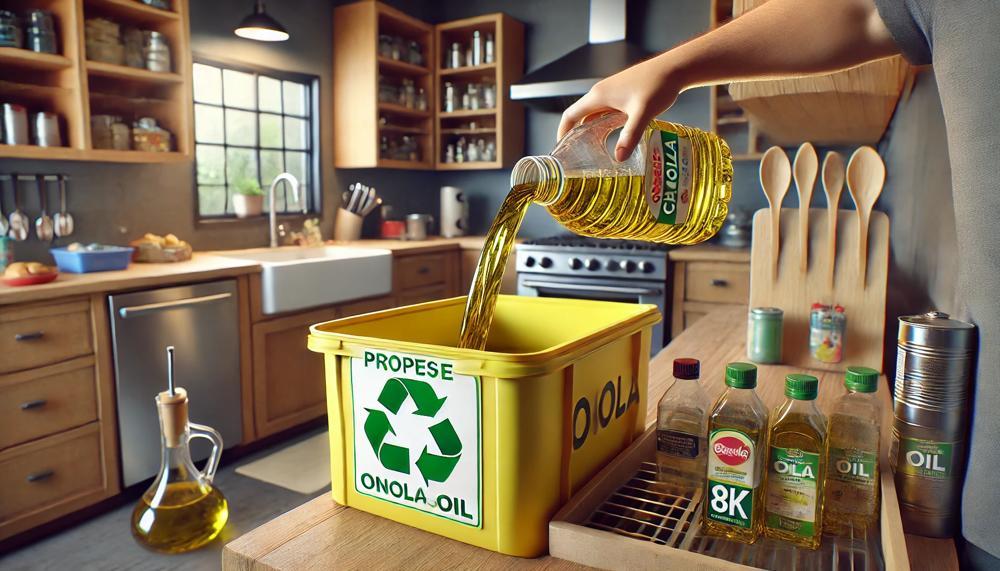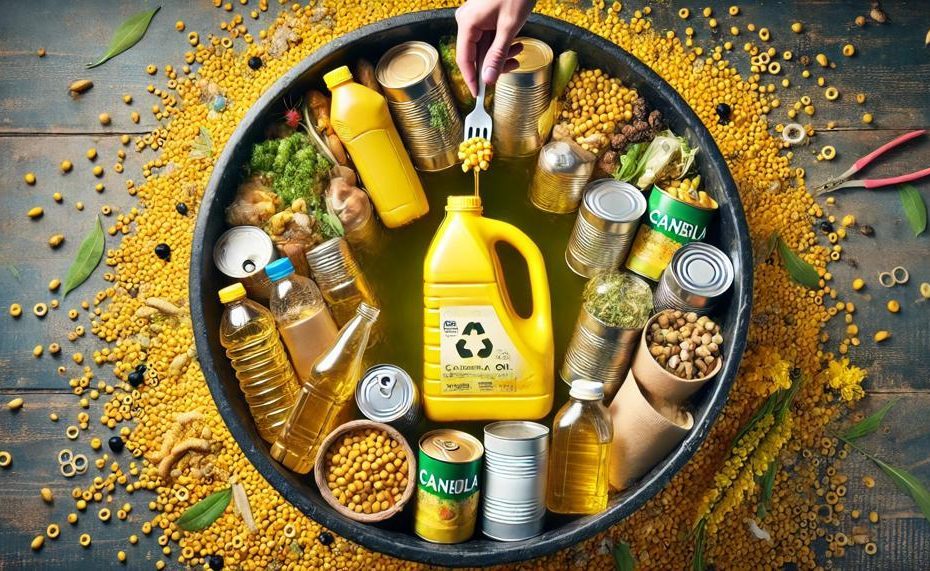You’ve finished frying up a storm, and now you’re left with a pan full of used canola oil. What should you do with it? Disposing of canola oil properly is important for both your home and the environment. Here’s a straightforward answer to get you started: never pour it down the drain. Instead, consider these key tips for safe disposal:
- Reuse It: If the oil is still in good condition (not smelly or cloudy), strain it and store it for future cooking.
- Cool and Contain: Let the oil cool completely, then pour it into a sealable, disposable container before throwing it in the trash.
- Absorb and Dispose: For small amounts, mix the oil with absorbent materials like cat litter or wood chips, and then discard it in your regular garbage.
- Composting: Small quantities can be added to your compost bin if you have one.
- Recycling Programs: Some local waste management services or nearby restaurants participate in recycling used oils into biofuels.
Disposing of canola oil responsibly helps prevent plumbing issues and contributes to a healthier environment. Ready to learn more? Let’s dive into the details.
Contents
Reuse Cooking Oil
To safely and effectively reuse cooking oil without causing harm to the environment, follow these detailed steps:
| Method | Details | Benefits |
| Filtering and Storing | Filter cooled oil and store in a clean container. | Prevents waste and allows for safe reuse. |
| Biofuel Production | Recycle oil through local companies. | Reduces greenhouse gas emissions. |
| Homemade Products | Create soap or candles from used oil. | Eco-friendly and cost-effective. |
| Composting | Use small amounts as a compost accelerator. | Enhances soil quality. |
| Animal Feed | Feed to farm animals in small quantities. | Reduces food waste. |
| Household Uses | Lubricate tools or use in art projects. | Versatile and practical. |
Pour Into Disposable Container
The best type of disposable container for disposing of canola oil is a sturdy plastic container with a tight-fitting lid. Here’s why this is the optimal choice:
- Durability: A sturdy plastic container ensures the oil doesn’t leak or seep through, which is crucial for avoiding messes or potential damage to your trash bin.
- Sealing Ability: The tight-fitting lid prevents any accidental spills and contains odors, making disposal more hygienic.
- Ease of Disposal: These containers are readily available, often reusable for similar disposal tasks, and fit easily into waste management systems without requiring special handling.
- Cost-Effectiveness: Using a plastic container is economical and repurposes materials that might otherwise be discarded.
Considerations:
- Cool the Oil First: Always let the oil cool to room temperature before transferring it to the container to avoid burns and melting the plastic.
- Absorbent Materials: For additional safety, mix the oil with absorbent materials like cat litter, coffee grounds, or sawdust before placing it in the container. This helps solidify the oil and prevents leakage.
- Environmental Impact: If you prefer a more eco-friendly option, use a biodegradable container. Ensure it’s still sealed tightly to prevent leaks.
Below is a comparison of various disposable container options for canola oil disposal:
| Container Type | Pros | Cons |
| Plastic Container | Durable, easily sealed, cost-effective | Non-biodegradable |
| Biodegradable Container | Environmentally friendly, compostable | May not be as leak-proof |
| Glass Jar | Reusable, leak-proof | Breakable, heavier |
| Fat Trapping Bag | Specially designed for oil, easy to use | Disposable, not always readily available |
Chill Until Solid
The process for chilling canola oil until it solidifies involves storing the oil in a refrigerator. This causes the oil to reach a temperature between 32°F and 39°F, at which point it will solidify.
Solidifying canola oil is essential for proper disposal. Liquid oil can create clogs in plumbing systems and is difficult to manage in waste streams. By chilling the oil until it solidifies, you can easily contain and dispose of it without the risk of spills or plumbing issues.
Steps for Chilling Canola Oil
Pour the Canola Oil into a Container
Use a sturdy plastic container with a tight-fitting lid to prevent leaks.
Place the Container in the Refrigerator
Store the container in the refrigerator. Ensure the temperature is between 32°F and 39°F.
Wait for Solidification
Leave the container in the refrigerator for several hours. The oil will gradually solidify as it cools.
Check the Consistency
Verify that the oil has solidified by checking if it has a firm texture.
Why Solidifying Canola Oil is Important for Disposal
Prevent Clogs
Solid oil won’t flow into plumbing systems, thus preventing blockages.
Easier Handling
Solidified oil is less messy and easier to handle compared to liquid oil.

Safer Disposal
Solid oil can be safely disposed of in regular trash, reducing the risk of environmental contamination.
Benefits of Using a Sturdy Plastic Container
| Benefit | Description |
| Durability | A sturdy plastic container resists breakage and is reliable for storing oil. |
| Sealing Ability | A tight-fitting lid ensures that the oil does not leak or spill. |
| Cost-Effectiveness | Plastic containers are affordable and readily available. |
Pour Small Amounts Into Trash
To dispose of small amounts of canola oil in the trash safely, follow these steps:
- Cool and Solidify the Oil: After cooking, let the canola oil cool down to room temperature. To speed up the solidification process, you can refrigerate it. Chilling it between 32°F and 39°F in a sturdy plastic container helps prevent spills and makes handling easier.
- Use a Sealed Container: Transfer the solidified oil into a durable container with a tight-fitting lid. This container should be leak-proof to avoid any mess in the trash. A plastic container or a jar works well for this purpose.
- Dispose in the Trash: Once the oil is securely contained, place the container in your regular trash bin. Ensure the lid is tightly sealed to prevent any leakage or odours.
- Avoid Pouring Down the Drain: Never pour canola oil down the drain as it can cause clogs and damage to plumbing. Solidifying the oil first is crucial to avoid these issues.
- Consider Recycling: Although small amounts can be trashed, consider recycling larger quantities. Many recycling centres convert used cooking oil into biodiesel fuel, which is environmentally friendly. Check for local recycling options on Earth911 by entering your zip code.
Combine With Other Material
When it comes to disposing of canola oil properly, several household items can be used to absorb the oil, making it safer and easier to discard. Here’s a handy table showcasing the best items to use:
| Item | Why It’s Effective | How to Use |
| Cat Litter | Absorbs liquid quickly and effectively | Mix the oil with cat litter in a sealable bag, then dispose of it in the trash. |
| Gravel | Provides excellent absorption and is easy to handle | Combine the oil with gravel in a container, seal it, and then discard it with regular waste. |
| Wood Chips | Absorbs oil efficiently and is biodegradable | Mix the oil with wood chips, place in a biodegradable bag, and dispose of it appropriately. |
| Paper Towels | Readily available and effective for small amounts | Saturate paper towels with the oil, seal in a plastic bag, and throw away. |
| Old Newspapers | Recycles old materials and absorbs oil well | Wrap the oil in several layers of newspaper, place in a bag, and discard. |
Using these items not only ensures safe disposal but also helps in recycling household waste.
Purchase a Grease Disposal System
When purchasing a grease disposal system for proper canola oil disposal, consider the following key factors:
| Factor | Description | Why It’s Important |
| Capacity | Choose a system with a capacity of at least 1 gallon. | Prevents overflow and ensures adequate storage for households or businesses using large quantities of canola oil. |
| Material and Design | Opt for containers made of stainless steel or high-density polyethylene (HDPE). | These materials are durable, resistant to corrosion, and can withstand the solidification of canola oil. |
| Maintenance and Cleaning | Look for systems with removable parts for easy cleaning and consider grease trap additives. | Canola oil can become rancid; easy cleaning prevents residue build-up and rancidity. |
| Cost | Balance quality and price, considering long-term maintenance costs. | Investing in a durable system can prevent costly pipe damage and reduce long-term expenses. |
| Environmental Impact | Choose eco-friendly systems with proper disposal or recycling options. | Proper disposal protects the environment and may offer recycling benefits. |
By considering these factors, you ensure that your canola oil disposal is efficient, safe, and environmentally friendly. This keeps your kitchen running smoothly and contributes to a healthier environment.
Recycle Cooking Oil
Disposing of used canola oil can be eco-friendly if done correctly. Here are some effective methods:
| Method | Description | Environmental Impact |
| Reuse and Repurpose | Convert to biodiesel or filter for fuel. | Reduces greenhouse gases, creates renewable energy. |
| Composting | Mix with absorbent materials to create compostable solid waste. | Eco-friendly, reduces landfill waste. |
| Household Disposal | Cool, contain in disposable container, and trash. | Safe if done correctly; prevents pipe clogging. |
| Recycling Services | Use local drop-off points or collection services. | Efficient, supports recycling infrastructure. |
| Commercial Disposal Systems | Utilize grease disposal kits for easy handling. | Convenient, reduces environmental contamination. |
By following these methods, you can ensure that your used canola oil is disposed of in an environmentally friendly manner.
Cooking Oil Disposal Don’ts
Common mistakes people make when disposing of canola oil include:
- Pouring it down the drain: This can clog pipes and sewers, causing major plumbing issues.
- Throwing it directly into the trash: This can create leaks, attract pests, and lead to unpleasant odours.
- Dumping it outside or in the yard: This can harm the environment by contaminating soil and groundwater, and it can be hazardous to wildlife.
Proper disposal methods:
| Method | Steps | Notes |
| Solidify and Dispose |
|
Prevents leaks and messes in the trash. |
| Recycling |
|
Find recycling centres here. |
| Reuse |
|
Ensure oil has not gone rancid before reusing. |
| Professional Disposal Services |
|
Ideal for large quantities of oil. |
These methods help protect the environment, keep your plumbing system safe, and adhere to local disposal regulations. Always check with local authorities for specific disposal guidelines and recycling options.
Conclusion
Safely disposing of used canola oil might seem tricky, but with a few thoughtful steps, you can protect both your home and the environment. Never pour oil down the drain; instead, consider these practical methods:
- Reuse: If the oil is still good—clear and not smelly—strain it to remove food particles and store it for future cooking.
- Contain and Dispose: Let the oil cool completely before pouring it into a sturdy plastic container with a tight-fitting lid. This method prevents leaks and odors, making it easy to discard in your regular trash.
- Absorb and Discard: For small amounts, mix the oil with absorbent materials like cat litter or wood chips before tossing it in the garbage.
- Compost: Adding small quantities to your compost pile can help accelerate decomposition, enriching your soil.
- Recycling Programs: Check if local waste management services or nearby restaurants accept used cooking oils for recycling into biofuels.
These methods ensure you’re disposing of canola oil responsibly, avoiding clogged pipes and contributing to a healthier planet.





